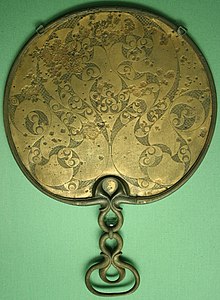Arte celta: Diferenzas entre revisións
Nova páxina: "{{entradución}} miniatura|Parte posterior dun espello de bronce britano, [[-50 - 50, exemplo do tema decorativo en espiral ..." |
(Sen diferenzas.)
|
Revisión como estaba o 23 de decembro de 2012 ás 17:19
Este artigo está a ser traducido ao galego por un usuario desta Wikipedia; por favor, non o edite. O usuario Breogan2008 (conversa · contribucións) realizou a última edición na páxina hai 11 anos. Se o usuario non publica a tradución nun prazo de trinta días, procederase ó seu borrado rápido. |


A Arte celta é a arte asociada cos pobos coñecidos como celtas; aqueles que falaban linguas celtas en Europa dende o período da prehistoria ata a idade moderna, así como a arte de pobos antigos, cuxa lingua é incerta, pero que teñen semellanzas culturais e de estilo cos falantes de linguas celtas.
Celtic art is a difficult term to define, covering a huge expanse of time, geography and cultures. A case has been made for artistic continuity in Europe from the Bronze Age, and indeed the preceding Neolithic age however archaeologists generally use "Celtic" to refer to the culture of the European Iron Age from around 1000 BC onwards, until the conquest by the Roman Empire of most of the territory concerned, and art historians typically begin to talk about "Celtic art" only from the La Tène period (broadly 5th to 1st centuries BC) onwards.[1] "Early Celtic art" is another term used for this period, stretching in Britain to about 150 AD.[2] The Early Medieval art of Britain and Ireland, which produced the Book of Kells and other masterpieces, and is what "Celtic art" evokes for much of the general public in the English-speaking world, is called Insular art in art history.
Notas
- ↑ Megaws, for example; see their introductory section, where they explain the situation & that their article will only cover the La Tène period.
- ↑ Technologies of Enchantment: Early Celtic Art in Britain, British Museum

